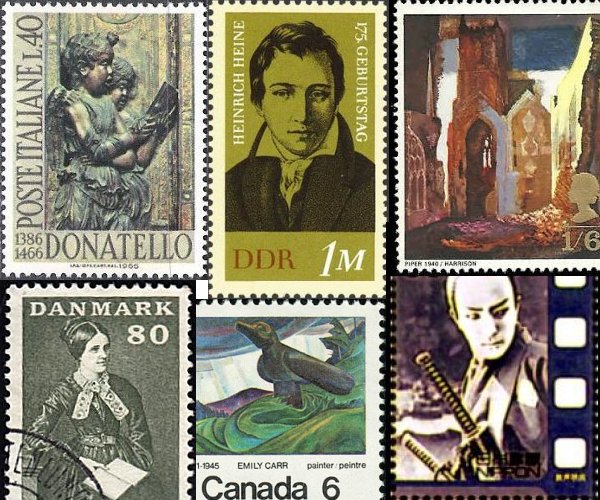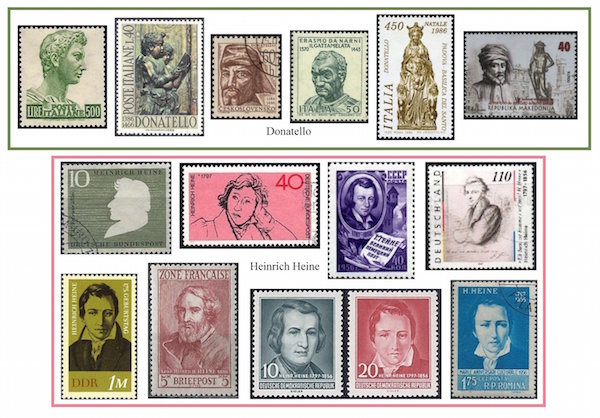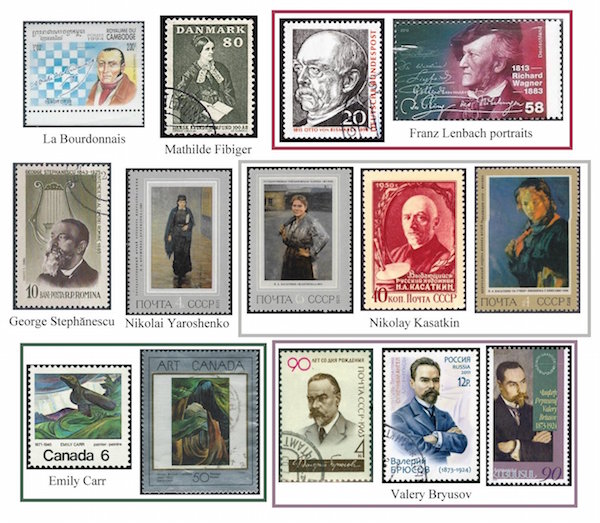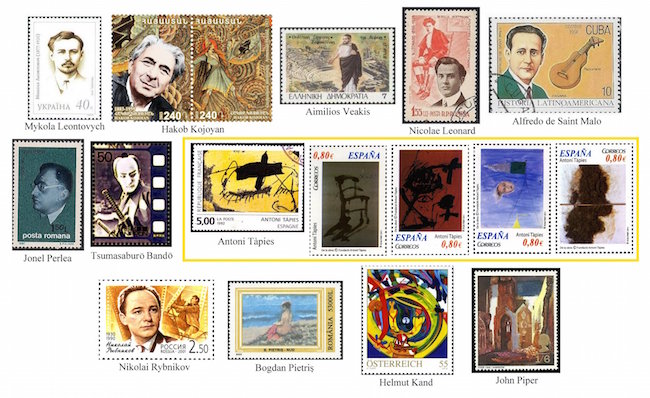The Arts on Stamps of the World — December 13
An Arts Fuse regular feature: the arts on stamps of the world.

By Doug Briscoe
Today’s avalanche of artists buries us with Donatello, Heinrich Heine, four Russians, four Romanians, painters from Germany, Canada, Armenia, Spain, and Britain (and Russia and Romania), a French chess master, a Danish novelist, a Ukrainian composer, actors from Greece and Japan (and Russia), and a Panamanian violinist.
One of the greatest of Renaissance artists breathed his last on this date in 1466. The artist we know as Donatello was born in Florence around 1386 as Donato di Niccolò di Betto Bardi. I expected to find a plethora of Donatello stamps out there, but the number is actually relatively small. Apparently there was none before 1957, when the head of the artist’s St. George (1416) was put onto an Italian definitive stamp. For the 500th anniversary of Donatello’s birth, Italy, showing the bronze Singing Angels (1447-50), was joined by Czechoslovakia. To celebrate the 600th anniversary of the condottiero Erasmo of Narni (1370–1443), known as Gattamelata (“The Speckled Cat”), the head from Donatello’s equestrian statue for Padua (1450) was selected. This work, harking back to ancient Rome, is cited by Wikipedia as “the earliest surviving Renaissance equestrian statue.” Also in Padua, from the Basilica del Santo, is a Madonna (c1448) that graced an Italian stamp for the Christmas season of 1986. Incidentally, another Donatello Madonna, the bas-relief The Madonna of the Clouds, can be seen at the MFA. I find it a bit surprising that Donatello’s most famous work, the exquisitely graceful bronze David, commissioned around 1430 by Cosimo de’ Medici, had to wait until the year 2016 before it showed up on a stamp, and then on one from Macedonia. Like the Gattamelata statue, the David was also a first: “the first known free-standing nude statue produced since antiquity.”
The great German-Jewish poet Heinrich Heine (1797 – 17 February 1856) was a favorite of Schumann, who set about three dozen of Heine’s poems. Wilhelm Killmayer set a similar number all at once in his cycle Heine-Lieder (1994). Heine’s works were also set by Schubert, Brahms, Liszt, Mendelssohn (notably “On Wings of Song”), and many others. Operas were composed by César Cui and Pietro Mascagn after the play William Ratcliff (1822), and Morton Feldman wrote a piece for female voice and chamber ensemble called I Met Heine on the Rue Fürstenberg (1971). All the stamps are German (with three from East Germany and one issued during post-war French occupation), except for the Russian and Romanian ones (what is it with Russians and Romanians today?) of 1956. His famous and oft-quoted line “Where they burn books, they will ultimately burn people as well” (from the 1821 play Almansor) is complemented by another prescient prediction: “A play will be performed in Germany which will make the French Revolution look like an innocent idyll.” (“The History of Religion and Philosophy in Germany”, 1835).
French chess master Louis-Charles Mahé de La Bourdonnais may have been the world’s strongest player in the early 19th century. At the time there was no official World Championship nor rating system, so his preeminence is not definitively established. Born on the island of La Réunion in or around 1795, La Bourdonnais came rather late to the game, learning it only in his late teens. After exercising poor judgment in speculations, he was compelled to make his living playing chess. He may have been the greatest of his day, but it was not a lucrative profession, and he died in penury in London on this date in 1840.

The Danish novelist Mathilde Fibiger (13 December 1830 – 17 June 1872) was an early feminist who took up the cudgels with her very first novel, Clara Raphael, Twelve Letters (Clara Raphael, Tolv Breve, 1851). Naturally, her radical notions were dismissed by many, but her position was also supported by a significant proportion of the Danish literary establishment, and it seems no one found fault with her fine qualities as a writer. In order to augment her small income, Fibiger translated from the German, made dresses and, finally, trained to become a telegraph operator. In 1866 she became the first woman in Denmark to work as a telegraphist. Her early death at 41 has been attributed to her work (overwork?) in that field. In 1970 a Mathilde Prize was established by the Danish Women’s Society to recognize those who have worked for gender equality.
German portraitist Franz Lenbach (13 December 1836 – 6 May 1904) is noted for his paintings of the celebrities of his milieu. His renderings of Otto von Bismarck (1884) and Richard Wagner were used for postage stamps remembering those prominent figures. Lenbach actually painted both men a number of times, Wagner, for example, in 1882 and years after the composer’s death in 1894. A less elevated subject was this Young Shepherd (1860). The artist was ennobled as Franz von Lenbach in 1882.
George Stephănescu (13 December 1843 – 25 April 1925) was a very important figure in Romanian national opera. While teaching at the Academy of Music in Bucharest, his birthplace, he was appointed conductor of the National Theater orchestra in 1877 and began to expand the repertoire from vaudevilles to musical comedies to opera, ultimately founding the first opera company in the Kingdom of Romania in 1885. Unfortunately it had to disband in 1902 when the government (under Newt Gingrichescu) cut its financial support. Besides his own five operas, Stephănescu wrote a Symphony in A (1869, apparently the first symphony written by a Romanian), an octet, a string quartet, and two piano sonatas.

Our next two artists not only share a nationality, a profession, and a birthday, but are both represented in the same stamp set, a 1971 Soviet issue devoted to Russian art. First we see Woman Student (1883) by Nikolai Yaroshenko (13 December [O.S. 1 December] 1846 – 7 July [O.S. 25 June] 1898), who was born in Poltava and became one of the leading figures among the Peredvizhniki (the Wanderers, an important group of artists of the day). Apart from his painting he was a military man who retired as a major general in 1892. The collection of his own works and others that had belonged to him and his widow was donated exactly one hundred years ago to what became the Poltava Art Museum.
The other Russian painter represented in that 1971 set is Nikolay Kasatkin (13 December 1859 –17 December 1930), thirteen years younger to the day, who was born and died in Moscow. Kasatkin studied for ten years at the Moscow School of Painting, Sculpture and Architecture (with Vasily Perov, among others) and taught there from 1894 to 1917. One of his subjects was lithography, which had been his father’s profession. He won a silver medal at the Paris Universal Exposition in 1900 and also exhibited at the Louisiana Purchase Exposition of 1904. An undertaking that occupied him for some thirty years was his collaboration with Ivan Sytin on illustrations for a popular almanac. He is regarded as a forerunner of Socialist Realism, as can be perceived in his Mine Worker (1894 or 1897) and, on a stamp from the very next year, 1972, his Pioneer Girl. An earlier stamp from 1956, which I’ve placed between the two paintings, honored the artist directly.
We’ll return to Russia in just a moment, but for the time being will remain with painting and explore the case of Canadian artist and writer Emily Carr (December 13, 1871 – March 2, 1945). She was born and grew up in Victoria. Her parents died young, by the time Carr was about twenty, and she studied art in San Francisco for two years and, later, in London. On her return she became fascinated with the indigenous peoples of the Pacific Northwest, which would develop into a recurring theme in her later work. In the meantime, she made further studies in France, where she was introduced to the Post-Impressionists and Fauvists. Back at home, response to her work was cool, and she largely gave it up between about 1913 and 1927, when she encountered members of the Group of Seven, Lawren Harris in particular encouraging her to resume her work. Carr had her first solo show in 1935. She suffered a series of strokes and heart attacks beginning in 1937. Two Canadian stamps both show paintings she made around 1931, Big Raven and Forest, British Columbia. I also found two others I’d like to share with you: Breton Church (1906) and, reflecting the native American inspiration, Kitwancool (1928). As for her writing, Carr penned a number of volumes of autobiography and fiction, much of it about indigenous peoples.
And, as promised, we go back to Russia for the Symbolist writer Valery Bryusov (December [O.S. 1 December] 1873 – 9 October 1924). Like Kasatkin, he was born and educated in Moscow, beginning his literary life while still at university there with his translations of Verlaine, Maeterlinck, Mallarmé, and Poe. Soon he began publishing his own poems, putting together a collection of his own work, written under various pen names, that he disingenuously called Russian Symbolists. An Anthology (1894–95). By 1900 he was viewed as an authority on art, and in 1904 he became editor of a prominent literary magazine. Apart from his poetry, criticism, and translations, he wrote historical novels (one of them, The Fiery Angel of 1908, served as the basis for an eponymous opera by Prokofiev), plays, some science fiction stories, and history.

The Ukrainian composer Mykola Leontovych (or Leontovich; December 13 [O.S. December 1] 1877 – January 23, 1921) specialized in a cappella choral music. In 1892, Leontovych went to the theological seminary in Kamianets-Podilskyi. On the death of the choir director there, the school offered the position to Leontovych, who promptly added secular fare to the customary repertoire of traditional church music. He completed his First Compilation of Songs from Podolia and began working on a second, which, although published in 1903, was later withdrawn when the composer, not fully satisfied with it, bought all 300 copies and had them destroyed. Leontovych taught at a variety of institutions in several cities. When the Ukrainian People’s Republic was established in 1918, he relocated to Kiev. His participation in the Ukrainian independence movement was likely the cause of his death: he was assassinated by a Soviet agent in 1921 and is held in the Eastern Orthodox Ukrainian Church to be a martyr. His music, inspired by his countryman Mykola Lysenko, includes the first liturgy written in modern Ukrainian and the famous Christmas carol “Shchedryk” (1904), known in English as the “Carol of the Bells”.
We hop back to the visual arts, but remain in the sphere of Russian influence, for Armenian painter Hakob Kojoyan (December 13, 1883 – April 24, 1959). He also worked in the graphic arts as a book illustrator and poster designer, and with architect Alexander Tamanian was the co-creator of the coat of arms for the First Republic of Armenia (1918-20). The stamp pair offers his work The Herald (1921). (Seen behind the artist’s head on the portrait stamp is not a different work, just a close-up of one section of the same piece.)
The Greek stage actor Aimilios Veakis (Αιμίλιος Βεάκης; December 13, 1884 – June 29, 1951) was orphaned very young and went into the Royal Drama School at 16. For a while he also studied painting, but went onto the stage with an acting company in Volos. Drafted into the Balkan Wars of 1912-13, he was decorated for valor. On demobilization he continued his acting career, which culminated in his directorship of the National Theater of Greece in 1932. During World War II he joined the National Liberation Front and gave performances for the partisans. At war’s end he was persecuted for his association with leftists. A highlight of his career was a 1930s performance of Sophocles’ Oedipus Rex, in which costume Veakis is shown on the stamp.
The Romanian tenor Nicolae Leonard (1886 – 24 December 1928) was known as “the Prince of Operetta”, though he also sang Canio at the age of 22 and enjoyed one of his great successes when he appeared in Massenet’s Werther. Quite a handsome fellow, Leonard was married to four beautiful women and divorced them all. He died of an unspecified (hereditary? tubercular?) illness at the age of 42.
Alfredo de Saint Malo was born in Panama City in 1898. He took violin lessons as a child and earned a government scholarship to study the instrument at the Paris Conservatoire. He won First Prize for Violin on his graduation in 1919. Saint Malo went to the US in 1925 for a well received series of concerts and followed that with a 1929 Italian tour during which he was given a private audience by Pope Pius XI (who blessed his violin) and is reported to have played for Mussolini. He returned to Panama in 1930, but was again in the US in 1934 for a private performance at the White House for President Franklin Delano Roosevelt. In 1941 a Panamanian Conservatory of Music was established with Saint Malo as its director, but from 1955 he served as professor of violin at the University of Texas at Austin, in which city he died in 1984.
Probably the most famous of our birthday musicians today was another Romanian, Jonel Perlea (1900 – 29 July 1970), a conductor known for his Italian and German opera performances. Born to a Romanian father and a German mother, he moved to Germany as a child on the death of his father. He made his debut in 1919 (or 1923) in Bucharest conducting one of his own works. It was this experience that led him to consider a conducting career. In 1926 he won the George Enescu Composition Prize. The following year he made his operatic conducting debut with Aida in Cluj-Napoca, and the year after that made his first appearance at the Bucharest Opera, where he was music director from 1934 until 1944. In that year, he and his wife were stopped on their way to Paris and arrested in Vienna and spent the rest of the war interned. After the war, Perlea conducted mostly in Italy, making his debut at the Met in 1949 with Tristan und Isolde. His own compositions include a piano concerto and other symphonic and chamber pieces.
Our second actor for today is Japan’s Tsumasaburō Bandō (December 13, 1901 – July 7, 1953), known as Bantsuma. Whereas Aimilios Veakis was exclusively associated with the stage, Bantsuma worked in film, although he began his studies in kabuki. He appeared in many silents in the genre known as jidaigeki (period films, typically involving samurai) and grew to be a great favorite. He was able to form his own production company in 1925, unprecedented for a film star in Japan. The company’s proposed second release in that very same year, Orochi, with its portrayal of a revolt against authority, drew much criticism from the government, which caused the film to be heavily edited and even re-shot. Naturally, the controversy only drew larger crowds to see it. Ironically, after World War II, the occupying US authority began to suppress jidaigeki films because of their apparent celebration of feudalism. Bantsuma formed an itinerant acting troupe but did also continue acting in films.
When he was only seventeen, the Spaniard Antoni Tàpies (13 December 1923 – 6 February 2012) nearly died of a heart attack resulting from tuberculosis. He convalesced for two years, during which he followed his loves of reading and art. Like so many budding artists, he prepared for a life in another field, in Tápies’s case the law, before throwing it up for painting when he was twenty. By the end of the 1950s his international reputation was well established. King Juan Carlos I ennobled him in 2010 as the 1st Marquess of Tàpies. One 1992 stamp from France was joined by a set of four from Spain in 2011, but my casual online searches turned up the title of not a one.
Our third and final actor on this December 13 is the Russian Nikolai Rybnikov (1930 –October 22, 1990). His career hit its peak in films of the late 1950s and early 60s, though he may be best known to American audiences for his role (as Vasily Denisov) in a film just outside that period, Sergei Bondarchuk’s War and Peace (1966-67).
For our last three subjects we turn again to painting. Romanian Bogdan Pietriș (December 13 , 1945 – August 6, 2006) studied at the Nicolae Grigorescu Institute of Fine Arts Personal and held many exhibitions, most of them in Bucharest, from 1975 on. Again I was unable to locate an online image of the painting on the stamp, labeled simply Nude.
The Austrian Helmut Kand, born in 1946 in Styria, was introduced to art at the age of four, when he picked up a brush and made a statement on one of his father’s landscape watercolors. Even before completing his studies at the Academy of Fine Arts in Vienna, Kand opened a studio with his friend F.X. Teubl in 1961. A few years later he made a pilgrimage to visit Salvador Dalí. A look at Kand’s work will signify why that’s important. Kand describes himself as a “poetic Surrealist”. The 2011 stamp shows his Annual Rings of Scent and Bliss. Other examples of his art include Redolent Remnants of the Day and Cat’s Night All Day Long.
The English painter John Piper (1903 – 28 June 1992) also worked in prints and stained-glass windows, besides designing opera and theater sets. Born in Epsom, Surrey, he lost an older brother to World War I at the Battle of Ypres. Piper’s own career would take him through another war. Like Antoni Tàpies he went through the motions of studying law, actually going so far as to work in his father’s firm for three years before turning down the offer of partnership. Well, Daddy wasn’t very pleased about that and disinherited him. Piper went happily off to art school and married a fellow student. In these years Piper also wrote art and music reviews for a number of periodicals. In 1937 John Betjeman invited Piper to work on a series of British travel guides, and Piper, always a lover of rural churches and of ruins, prepared (i.e., wrote and illustrated) the volume for Oxfordshire. He had his first one-man show the next year, displaying his landscapes along with more abstract pieces. During the war he was assigned to document bomb damage to landmark buildings, and one of his projects as official war artist was to visit Coventry the day after the ferocious air raid of 14 November 1940. Another such project took him to Bristol, where his sketches resulted in the painting seen on the stamp, St Mary-le-Port, Bristol (1940), now at the Tate Gallery. Piper, on the suggestion of Kenneth Clark, was also put to work capturing at risk sites on canvas. Still during the war, Piper accepted a commission from Sir Osbert Sitwell to do paintings for his house and to illustrate his autobiography. A similar project was undertaken at Knole House for Edward Sackville-West. It was after the war that Piper began to concern himself with working in stained glass, and he also designed tapestries for various cathedrals, productions for several of Benjamin Britten‘s operas at Glyndebourne and, in 1977, the firework displays for the Queen’s Silver Jubilee! It’s sad to note that so rich a life ended with, as it were, a whimper, as John Piper succumbed to complications from Alzheimer’s. But rather than end on too somber a note, have a look at Piper’s Byland Abbey. On seeing some of Piper’s work in this mode, King George VI remarked, “You seem to have very bad luck with your weather, Mr Piper.”
Stampless still are Afrikaner author Sir Laurens van der Post (13 December 1906 – 16 December 1996), American poet Kenneth Patchen (December 13, 1911 – January 8, 1972), and beloved Canadian actor Christopher Plummer (born December 13, 1929), who turns 88 today.
A graduate of the University of Massachusetts with a B.A. in English, Doug Briscoe worked in Boston classical music radio, at WCRB, WGBH, and WBUR, for about 25 years, beginning in 1977. He has the curious distinction of having succeeded Robert J. Lurtsema twice, first as host of WGBH’s weekday morning classical music program in 1993, then as host of the weekend program when Robert J.’s health failed in 2000. Doug also wrote liner notes for several of the late Gunther Schuller’s GM Recordings releases as well as program notes for the Boston Classical Orchestra. For the past few years he’s been posting a Facebook “blog” of classical music on stamps of the world, which has now been expanded to encompass all the arts for The Arts Fuse.
